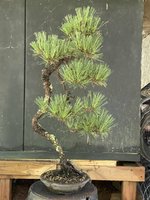I'll look for your thread to address your specific questions.
But, since it is appropriate for this thread, a bit about "half bare rooting":
You will not see much, if any, description or instructions about "half bare rooting" (HBR) in any book. To the best of my knowledge, this technique started with Boon. I may be wrong about that, if so, I apologize in advance. But, until I started studying with Boon, I had never heard of it, and I've been doing bonsai 40 plus years.
Bare rooting deciduous trees just before the bud out has long been a standard procedure. They appear to do just fine. Conifers, however, don't like it, and it can seriously set them back or kill them! That is one of the reasons imported conifers are so expensive: they are bare rooted when shipped, and then reported upon arrival here in the US. Unfortunately, many don't survive being barerooted.
Conifers prefer a free draining soil when kept in bonsai pots. Newly collected yamadori, and even nursery grown trees often have soil that provides inadequate drainage, or stays too wet. This can cause either root rot, or there can just be no active roots at all in the part of the root ball closest to the trunk.
So, this old "mountain duff" in the case of yamadori, or old worn out potting soil in the case of nursery material needs to be replaced. Soil close to the bottom of the trunk needs to be replaced? How do we do that without bare rooting the tree?
HBR:
Start off doing a regular "repot" procedure. Then, determine which half of the rootball is the "weakest". Bare root the weak half. Leave the strongest part untouched so it will continue to sustain the tree while the weak part regenerates. If the tree is really weak, don't do a full "half". Do a third, or a quarter. The object is to begin replacing the old soil with new hood bonsai soil, but not kill the tree in the process.
You've heard the old joke, The Doctor comes into the waiting room and tells the family that "The operation was a success, but the patient died"... We don't want that!
So, using root hooks, bent tip tweezers, chopsticks, etc., remove as much soil as you can on the weak side, and get up under the trunk and get the old soil out from under 1/2 of it. Wash it off with a gentle rinse of water. Don't pressure wash it off! Try to leave the other side as undisturbed as possible.
Then pot in a pot, or box, or colander, being sure to get new soil back into where you removed all the old soil, leaving no air pockets. Use chopsticks, but don't overdo it! It's easy to break what few good roots you have with over enthusiastic chopsticking! Backfill with soil, and settle it in by giving the pot a few taps with the meat if your fist. Water throughly.
In a couple years, do the other half. If you only did a third, you only have to wait a year to do another third.
Now... The question has come up: "What about watering?" Should I water for the new soil? Or the old soil?
The answer: it's virtually impossible to overwater good bonsai soil. The drainage is such that excess water will pass right through. Therefore, water according to the needs of the old soil. Certainly, if the old soil is really water retentive, and you don't need to water very often, you may need to make sure the new soil. Usually, the problem is the old soil is so compacted that water doesn't penetrate into the center of the rootball. In this case, you need to water a lot do that the old rootball gets some water. The new soil will let any excess drain on out.
Now, why isn't this in any of the books? For the most part, the books discuss how to repot existing bonsai that have already been growing in good bonsai soil. In Japan, they grow their nursery stock in bonsai soil, so a switch over isn't needed.
Finally, don't forget that a HBR is still considered major rootwork. It's best to give the tree a rest after that to let it build a good strong root system. If you have a good root system, then you can be more aggressive with other training procedures. The fact that you needed to do a HBR is an indication that the tree is weak, and so it would be better to wait until the tree is stronger to do anything else.




